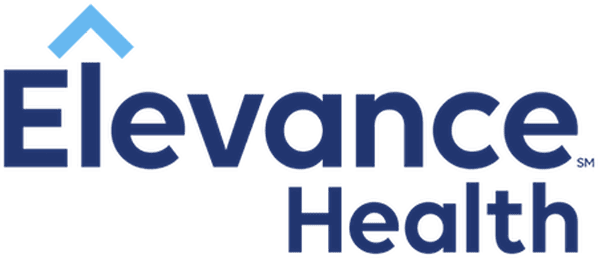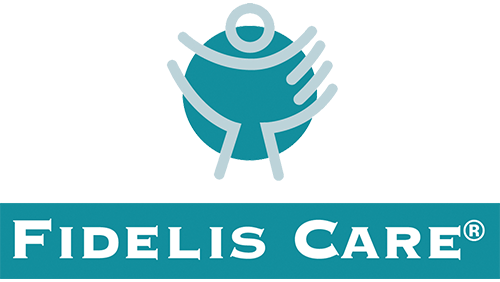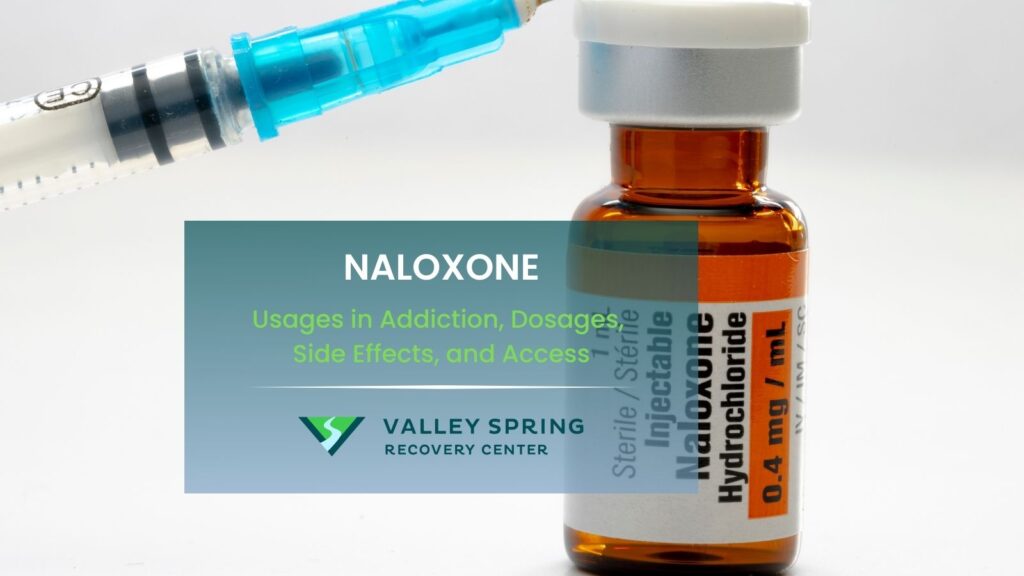Drug Abuse Screening Test (DAST-10): Definition, Description, Scoring, Application and Limitation
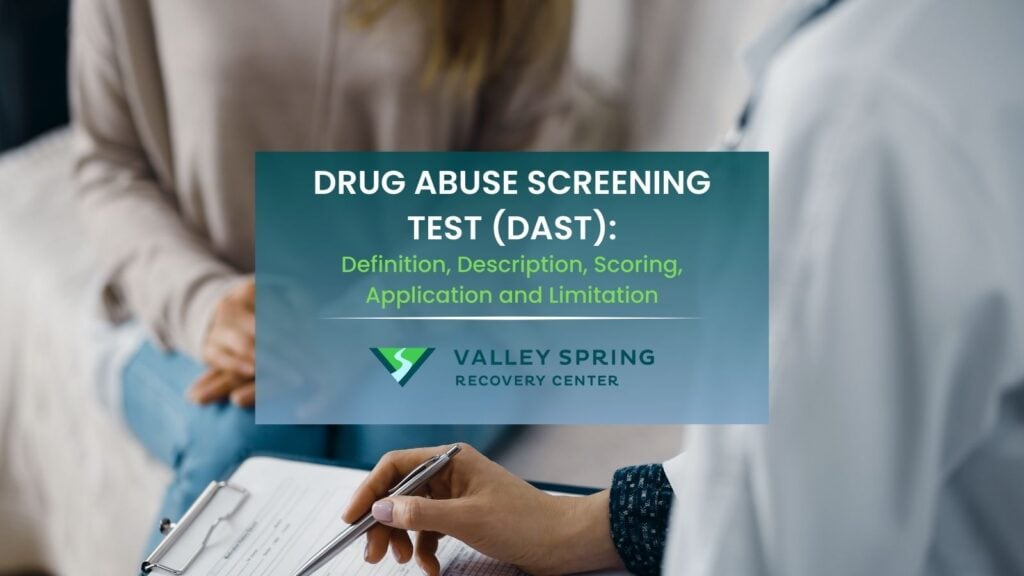
The Drug Abuse Screening Test (DAST or DAST-10) is a standardized self-report questionnaire used to assess an individual’s lifetime history of drug use and related problems, providing a comprehensive evaluation of drug abuse or dependence across various substances.
The DAST is applied by administering a self-report questionnaire to individuals, assessing their lifetime history of drug use and related problems to identify potential drug abuse or dependence.
The Drug Abuse Screening Test (DAST) is scored by assigning points to each response on the questionnaire, and the total score is used to categorize individuals into different risk levels, indicating the severity of their drug-related concerns.
The benefits of DAST include being a standardized and comprehensive screening tool for assessing drug-related problems, aiding in risk stratification, treatment guidance, and longitudinal monitoring.
However, limitations include potential self-report biases, limited cultural adaptations, simplified scoring, and the need for additional assessments for a formal diagnosis of substance use disorders.
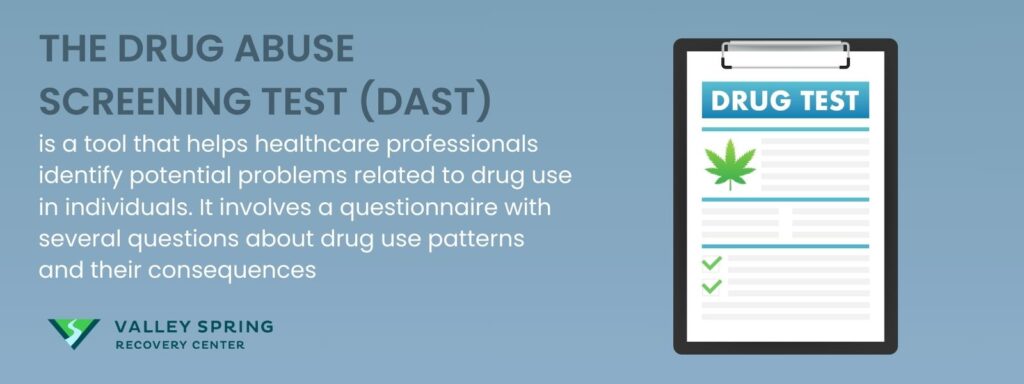
What is the Drug Abuse Screening Test (DAST)?
The Drug Abuse Screening Test (DAST) is a tool that helps healthcare professionals identify potential problems related to drug use in individuals. The DAST-10 starts with the individual taking the test selecting their primary drug or drugs of choice and frequency of use, followed by 10 questions to identify substance use patterns. The DAST-10 was developed and copyrighted in 1982 by Harvey Skinner, PhD and the Centre for Addiction and Mental Health, Toronto, Canada.
There are slightly different versions of DAST tests like the DAST A which is used for adolescents. According to research by Mogadam, et al, in a diverse sample of 741 justice-involved youth, titled Examining the measurement invariance and psychometrics of the drug abuse screening test for adolescents (DAST-A) in Justice-involved youth The DAST-A exhibited strong reliability in the overall sample and subgroups. It demonstrated good convergent and concurrent validity. Logistic regression results indicated that with each unit increase in DAST-A score, the odds of a substance use disorder (SUD) diagnosis increased by 23% in the overall sample.
By answering the questions honestly, the test provides insight into the likelihood of drug abuse or dependence. The DAST is used to screen individuals and guide healthcare professionals in determining appropriate interventions and treatment options. It is a helpful tool in understanding and addressing drug-related concerns.
Did you know most health insurance plans cover substance use disorder treatment? Check your coverage online now.
How is the DAST tool Used?
The DAST tool is used as a screening instrument in the following ways:
- Administration: The DAST questionnaire is typically administered by a healthcare professional or self-administered by the individual. It consists of a series of questions related to drug use and its consequences.
- Scoring: Each question in the DAST is assigned a specific score based on the response provided. The scores are then summed up to obtain a total score.
- Interpretation: The total score on the DAST indicates the level of risk or severity of drug-related problems. Different cutoff scores are used to categorize individuals into low-risk, moderate-risk, or high-risk groups.
- Intervention and Treatment: Based on the DAST score and risk level, healthcare professionals will determine appropriate interventions and treatment options. Higher scores or higher risk levels indicate the need for further assessment, referral to specialized services, or targeted interventions.
- Follow-up and Monitoring: The DAST can be used longitudinally to track changes in drug use patterns over time and assess the effectiveness of interventions. It helps in monitoring progress and providing support to individuals in managing their drug-related concerns.
Overall, the DAST is a tool used to identify and assess potential drug-related problems, guiding healthcare professionals in providing appropriate interventions and support to individuals who may be at risk for drug abuse or dependence. It is an opportunity for a professional to introduce the following interventions if necessary.
- Brief Education on Alcohol Use: Educate patients about low-risk alcohol consumption levels and the dangers of excessive drinking. Providing clear information on the risks of alcohol misuse can help patients make informed decisions about their drinking habits.
- Brief Intervention Techniques: Implement patient-centered discussions using Motivational Interviewing techniques to increase patients’ awareness of their substance use and boost their motivation to change. These brief interventions typically last 3-15 minutes and should be conducted during the same session as the initial screening. Regular, repeated sessions are more effective than a single intervention.
- Referral to Specialized Care: When a patient is ready to seek treatment, a referral is a proactive step to connect them with specialized care for substance use disorders. Patients are directed to alcohol and drug treatment experts for comprehensive assessments and, if necessary, treatment. Treatment plans may also include prescribing medications for substance use disorders as part of the patient’s routine primary care.
If you are using substances and wish to take the Drug Abuse Screening Test, a version of the test is below along with how to score and interpret the test which should be done by a licensed professional.
How To Take The Drug Abuse Screening Test (DAST)
If you are using substances and wish to take the Drug Abuse Screening Test (DAST), a version of the test is provided below. Check each substance used, how often you use the substances and then answer them below. Scoring and interpretation of the test should be done by a licensed professional.
Substances
- Methamphetamines (speed, crystal)
- Cocaine
- Cannabis (marijuana, pot)
- Narcotics (heroin, oxycodone, methadone, etc.)
- Inhalants (paint thinner, aerosol, glue)
- Hallucinogens (LSD, mushrooms)
- Tranquilizers (valium)
- Other: ______________________________
How often have you used these drugs?
- Monthly or less
- Weekly
- Daily or almost daily
Questions
- Have you used drugs other than those required for medical reasons?
- No
- Yes
- Do you abuse more than one drug at a time?
- No
- Yes
- Are you always able to stop using drugs when you want to?
- No
- Yes
- Have you ever had blackouts or flashbacks as a result of drug use?
- No
- Yes
- Do you ever feel bad or guilty about your drug use?
- No
- Yes
- Does your spouse (or parents) ever complain about your involvement with drugs?
- No
- Yes
- Have you neglected your family because of your use of drugs?
- No
- Yes
- Have you engaged in illegal activities in order to obtain drugs?
- No
- Yes
- Have you ever experienced withdrawal symptoms (felt sick) when you stopped taking drugs?
- No
- Yes
- Have you had medical problems as a result of your drug use (e.g., memory loss, hepatitis, convulsions, bleeding)?
- No
- Yes
Have you ever injected drugs?
- Never
- Yes, in the past 90 days
- Yes, more than 90 days ago
Have you ever been in treatment for substance abuse?
- Never
- Currently
- In the past
How to Interpret DAST answers and scoring?
The Drug Abuse Screening Test (DAST) is scored by assigning points to each response provided by the individual. A professional interprets the cumulative score to determine the risk level of substance use. The total score indicates the risk level, which can be categorized as no risk, risky, harmful, or severe.
“Yes” responses receive one point each, except for question #3, which receives one point for a “No” answer. Points are totaled to determine the score, which correlates with a risk level.
The table below describes the score range, associated risk level, and recommended actions based on the score.
| Score | Risk Level | Indicated Action |
|---|---|---|
| 0 | No Risk | None |
| 1-2 | Risky | Offer brief education on the benefits of abstaining from drug use and monitor at future visits. |
| 3-5 | Harmful | Conduct a brief intervention and offer options that include treatment. |
| 6+ | Severe | Provide brief education on low-risk consumption levels, perform a patient-centered discussion using Motivational Interviewing to enhance awareness and motivation to change, and facilitate access to specialized care if the patient is ready for treatment. |
Contact us today to schedule an initial assessment or to learn more about our services. Whether you are seeking intensive outpatient care or simply need guidance on your drug addiction journey, we are here to help.
How Does the DAST Differ from Other Substance Use Screening Tools?
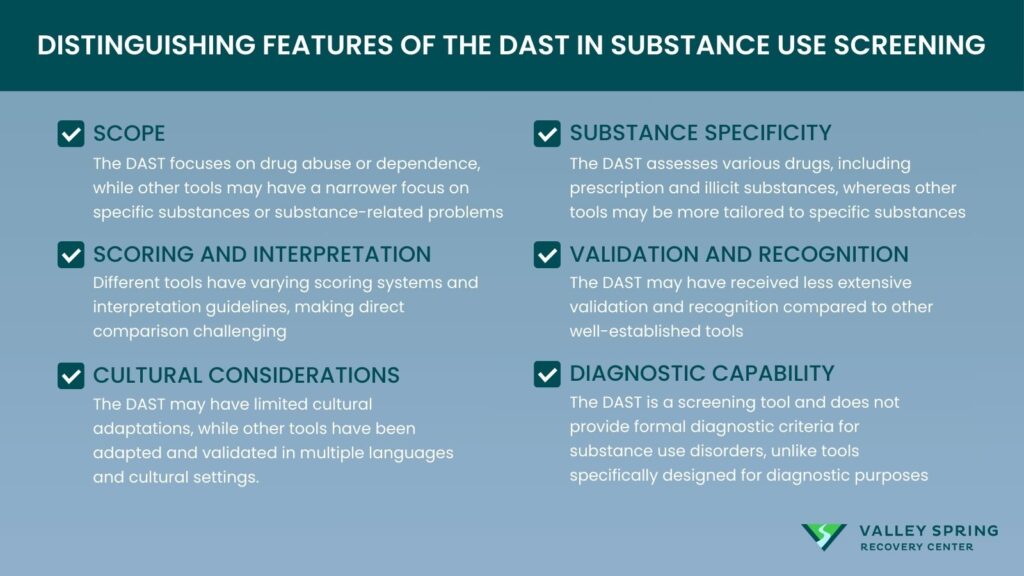
The differences between the Drug Abuse Screening Test (DAST) and other substance use screening tools include:
- Scope: The DAST focuses on drug abuse or dependence, while other tools may have a narrower focus on specific substances or substance-related problems.
- Substance Specificity: The DAST assesses various drugs, including prescription and illicit substances, whereas other tools may be more tailored to specific substances.
- Scoring and Interpretation: Different tools have varying scoring systems and interpretation guidelines, making direct comparison challenging.
- Validation and Recognition: The DAST may have received less extensive validation and recognition compared to other well-established tools.
- Cultural Considerations: The DAST may have limited cultural adaptations, while other tools have been adapted and validated in multiple languages and cultural settings.
- Diagnostic Capability: The DAST is a screening tool and does not provide formal diagnostic criteria for substance use disorders, unlike tools specifically designed for diagnostic purposes.
What are the Different Risk Levels Identified by the DAST?
The Drug Abuse Screening Test (DAST) categorizes individuals into different risk levels based on their total score:
1. Low Risk
People with a low DAST score typically fall into this category. It suggests that they have minimal or no significant drug-related problems or dependence.
Rediscover Life at Valley Spring Recovery Center
Get the compassionate support you deserve. We're here to help you reclaim joy, wellness, and a brighter future.
Verify Benefits
2. Moderate Risk
Individuals with a moderate DAST score indicate a moderate level of drug-related problems. They have experienced some negative consequences or difficulties due to drug use, but the severity and impact wouldn’t be as severe as those in the high-risk category.
3. High Risk
Individuals with a high DAST score are considered at high risk for drug abuse or dependence. They have experienced significant negative consequences, dependency symptoms, or have a greater likelihood of struggling with drug-related problems.
It’s important to note that the specific cutoff scores for each risk level differ based on the guidelines or recommendations used in a particular healthcare setting.
What are the Benefits of the DAST Tool?
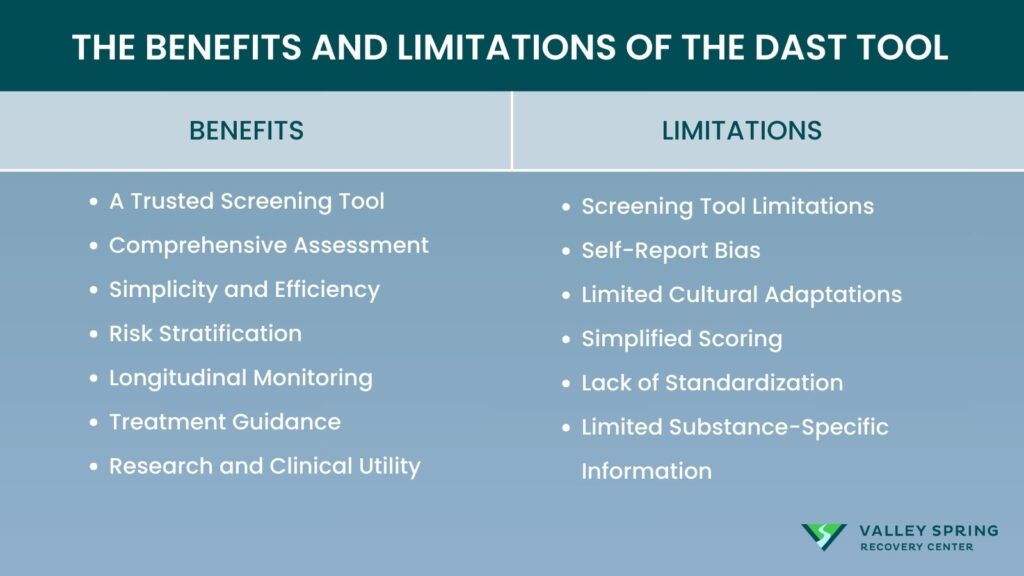
The Drug Abuse Screening Test (DAST) offers several benefits including:
Are you covered for treatment?
Valley Spring Recovery Center is an approved provider for Blue Cross Blue Shield and Cigna, while also accepting many other major insurance carriers.
Check Coverage Now!1. A Trusted Screening Tool
The DAST serves as a reliable and standardized screening tool to identify individuals who may be at risk for drug abuse or dependence. It helps healthcare professionals quickly and efficiently assess drug-related concerns.
The study by El-Bassel et al. (1997) titled Assessing the utility of the Drug Abuse Screening Test in the workplace aimed to determine the utility and assess the psychometric properties of the Drug Abuse Screening Test (DAST) in a workplace setting. The study concluded that the DAST is a useful and psychometrically sound tool for screening drug abuse in the workplace, which can help in identifying individuals who may benefit from EAP services related to substance use
2. Comprehensive Assessment
The DAST evaluates a broad range of drugs, including both prescription and illicit substances. This comprehensive approach ensures that various types of drug use and related problems are considered during the screening process.
3. Simplicity and Efficiency
The DAST is relatively easy to administer and score, making it a practical tool for healthcare professionals. It consists of a straightforward questionnaire that must be completed by the individual or administered by a healthcare professional in a relatively short amount of time.
Did you know most health insurance plans cover substance use disorder treatment? Check your coverage online now.
4. Risk Stratification
The DAST categorizes individuals into different risk levels based on their total score. This helps healthcare professionals differentiate between individuals with minimal or no drug-related problems, moderate risk, and those at high risk for drug abuse or dependence. This risk stratification assists in tailoring interventions and treatment plans accordingly.
5. Longitudinal Monitoring
The DAST can be used longitudinally to track changes in drug use patterns over time. It helps healthcare professionals assess the effectiveness of interventions, monitor progress, and provide ongoing support to individuals in managing their drug-related concerns.
6. Treatment Guidance
Based on the DAST score and risk level, healthcare professionals can determine appropriate interventions and treatment options. It helps in identifying individuals who require further assessment, referral to specialized services, or targeted interventions to address their drug-related problems.
Contact us today to schedule an initial assessment or to learn more about our services. Whether you are seeking intensive outpatient care or simply need guidance on your drug addiction journey, we are here to help.
7. Research and Clinical Utility
The DAST has been used in both research and clinical settings, providing a valuable tool for studying drug abuse and dependence. Its widespread use and familiarity in the field contribute to its clinical utility and facilitate communication among healthcare professionals.
While the DAST offers numerous benefits, it’s important to consider its limitations and use it as part of a comprehensive assessment process that considers individual circumstances and clinical judgment.
What are the Limitations of The DAST Tool?
Here are some of the limitations associated with the DAST:
1. Screening Tool Limitations
The DAST tool does not provide a formal diagnosis of substance use disorders. It serves as an initial assessment to identify potential drug-related problems but must be followed by a comprehensive evaluation for a definitive diagnosis.
Rediscover Life at Valley Spring Recovery Center
Get the compassionate support you deserve. We're here to help you reclaim joy, wellness, and a brighter future.
Verify Benefits
2. Self-Report Bias
The DAST relies on individuals’ self-reporting of their drug use and related problems. This is subject to biases, such as underreporting or overreporting, due to social desirability or memory issues. Consequently, the accuracy of the results may be influenced by the honesty and accuracy of the individual’s responses.
3. Limited Cultural Adaptations
The DAST doesn’t have extensive cultural adaptations or norms specific to diverse populations. This affects its cross-cultural validity and relevance, leading to variations in the interpretation of scores across different cultural contexts.
4. Simplified Scoring
The DAST utilizes a simplified scoring system, assigning equal weight to each question. This approach may not fully capture the complexity and nuances of drug use and related problems, potentially limiting its accuracy in assessing the severity of specific issues.
Are you covered for treatment?
Valley Spring Recovery Center is an approved provider for Blue Cross Blue Shield and Cigna, while also accepting many other major insurance carriers.
Check Coverage Now!5. Lack of Standardization
Although the DAST has been widely used, different versions and variations of the tool exist. This lack of standardization of results in variations in scoring criteria, interpretation guidelines, and risk levels across different versions, potentially affects the consistency of results and making comparisons between studies or settings challenging.
6. Limited Substance-Specific Information
While the DAST provides a comprehensive assessment of drug use, it’s not capture detailed information about specific substances, patterns of use, or associated risks. This limitation hinders a comprehensive understanding of the individual’s drug-related concerns and may require additional assessments or tools for a more in-depth analysis.
What substances are assessed by the DAST?
The Drug Abuse Screening Test (DAST) assesses a broad range of substances, including both prescription and illicit drugs. It is designed to evaluate drug abuse or dependence, making it applicable to various substances such as opioids, stimulants, sedatives, hallucinogens, cannabis, and others. The DAST provides a comprehensive assessment of drug-related issues beyond a specific substance focus.
Did you know most health insurance plans cover substance use disorder treatment? Check your coverage online now.
Can the DAST be self-administered?
Yes, the Drug Abuse Screening Test (DAST) can be self-administered by individuals. It is designed to be a self-report questionnaire that individuals can complete on their own. The DAST typically consists of a series of questions related to drug use and associated problems, and individuals can provide their responses based on their own experiences. However, in some cases, healthcare professionals may also administer the DAST as part of a clinical assessment.
Is the DAST applicable to both current and past drug use?
Yes, the DAST is applicable to both current and past drug use, providing a comprehensive assessment of an individual’s lifetime history of drug use and related problems.
How does the Drug Abuse Screening Test (DAST) compare to the Alcohol Use Disorders Identification Test (AUDIT) in terms of screening for substance use disorders?
The Drug Abuse Screening Test (DAST) and the Alcohol Use Disorders Identification Test (AUDIT) are both tools used to screen for substance use disorders, but they target different substances. The DAST is specifically designed to identify drug use problems, excluding alcohol, and assesses various aspects of drug use, such as the frequency and impact on daily life. In contrast, the AUDIT focuses exclusively on alcohol use and evaluates patterns of drinking behavior and associated risks. Both tools are valuable for early detection and intervention, but they must be used appropriately based on the substance in question to ensure accurate and relevant screening.
Contact us today to schedule an initial assessment or to learn more about our services. Whether you are seeking intensive outpatient care or simply need guidance on your drug addiction journey, we are here to help.
Are there any cultural or contextual considerations when using the DAST?
Yes, cultural and contextual considerations are important when using the Drug Abuse Screening Test (DAST). It’s crucial to recognize that cultural factors, beliefs, and norms related to substance use can vary across different populations.
This was discussed in a research by Douglas et al (2024) titled Cultural Considerations in Caregiver-Implemented Naturalistic Developmental Behavioral Interventions: A Scoping Review, highlighting the importance of cultural relevance in interventions and noting a lack of research with diverse populations. It also pointed out the limited description related to cultural adaptations of these interventions.
In this regard, the DAST may not account for specific cultural contexts or variations in drug abuse patterns. Therefore, it’s important to interpret the results of the DAST with cultural sensitivity and consider any potential cultural biases or influences that may impact the assessment of drug-related concerns.
How is the DAST different from the MAST?
The Drug Abuse Screening Test (DAST) assesses a wide range of drug use, including illicit and prescription substances, while the Michigan Alcohol Screening Test (MAST) specifically evaluates alcohol use and related problems. Both are self-report questionnaires but focus on different substances and behaviors, catering to specific assessment needs.
Share This Post







